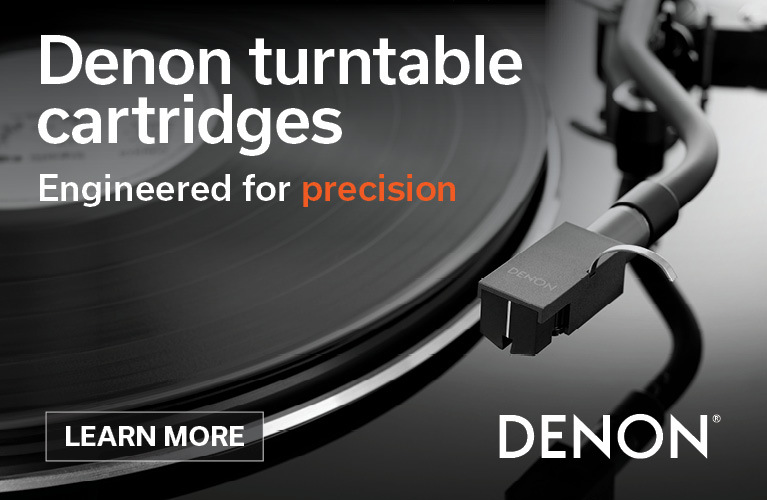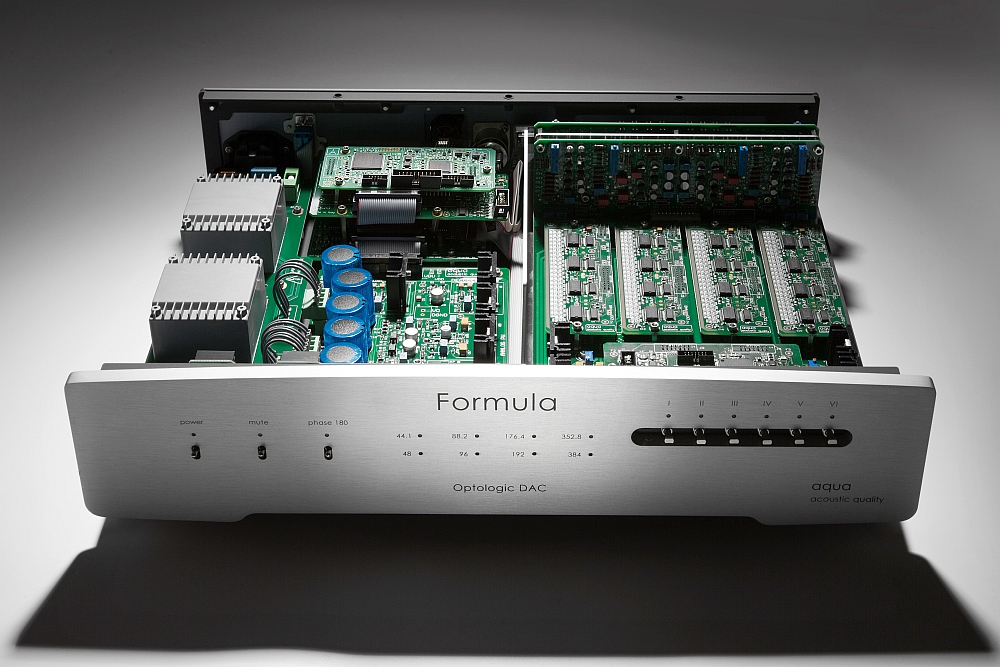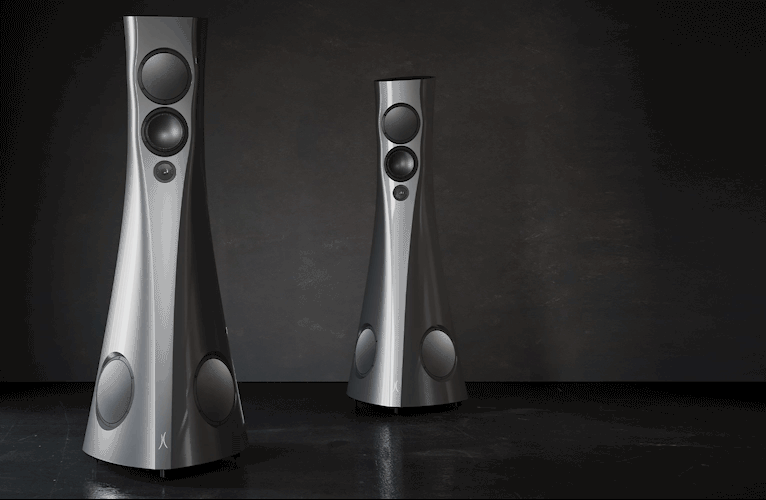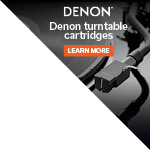For the past year and a half, my reference digital-to-analogue converter of choice has been the Aqua Acoustic Quality Formula xHD. It remains spell-binding, a source of constant pleasure and musical satisfaction, in an era when last month’s DAC-of-the-month is tomorrow’s landfill.
Knocking on Heavens Door
When a clodhopper of an installer trashed my prized Lyra phono cartridge a while back, the Aqua Formula xHD has served as my primary source and is the first digital product that has not had me gazing at my shoes at some point in a recording and wondering whether I should get the washing done. Now, I’m a lazy sod and will be the first to admit that digital playback has its attractions. Particularly in the area of high resolution streaming and file playback, digital sound quality is improving at an exponential rate. But the Aqua Formula xHD DAC is the first in my experience where I simply do not have to justify the listening experience as being not bad for digital.
This wasn’t always the case. I was working in an alternative music record store shortly after the introduction of the CD (I hear our Editor, as a young man, was greatly inspired by our label artists). There we all stood, arms crossed, scratching our collective heads, checking out the brave new world CD pressing of R.E.M.’s Reckoning. They were a good band back then but compared to vinyl, CD sounded like the opening act at a show being denied the full use of the PA, notwithstanding the “indie” recording budget.

In a review of Television’s The Blow Up, an incredible but quasi-bootleg live performance, critic Robert Christgau, lamenting the poor sound quality of the original cassette only release, concluded that “audio makes the difference between a laudable document and living history”. Well here I am, it’s late at night and the volume is way down low, being thoroughly captivated by a CD reissue of that old cassette tape on the Aqua La Diva CD transport and Formula xHD. The recording has never sounded more vital, compelling and alive. Even at very low volume, there is no loss of detail, confusion or soundstage collapse. More importantly, the musicians’ intent, the unique, markedly contrasting touch and feel of guitarists, Tom Verlaine and Richard Lloyd, is lucidly – and vividly – conveyed.
This is not your old (man’s) 16 bit/44.1 listening experience. I’m hearing living history where no excuses need be made even when the original recording is bootleg quality poor. Since this magazine’s inception, I’ve had access to and declined to review some digital products that are far more expensive than the Aqua Formula xHD. It really is a rather special device, “A Machine Spiritual (In the People’s Key)” as Bright Eyes once sang, forming “some kind of code / Of flesh and bone”.
Guiding Light
Aqua, short for Acoustic Quality, was founded in 2010 in Milan, Italy by Cristian Anelli, the company’s Chief Engineer and product designer. In email correspondence, Anelli describes himself as an “experimenter free of preconceptions”. Aqua’s “singular focus” has always been on innovatively designed digital source components and the singular sounding Formula xHD is the latest version of the acclaimed Formula flagship DAC.
The original Formula was the first Aqua DAC to implement what Aqua calls its proprietary ‘Optologic’ conversion system. Rather than a metal and wire connection which can cause deleterious noise, the Formula uses light and glass to opto-couple the digital to the analogue stages. Aqua also believes that “the more musical D/A conversion system” is based on the multi-bit or resistor ladder type. So, instead of tweaking an OEM converter chip, Aqua rolls its own bespoke converter circuit based on sets, or banks, of high precision discrete resistors commonly known as the ‘R2R’ design principle. The Formula xHD has a sign-magnitude converter structure which requires four 24-bit resistor banks, a pair for each stereo channel, one for each half of the sine wave, with each one being made up of very low tolerance discrete resistors.
Seemingly everything about the design of the Formula xHD is geared toward the purest of signal conversion and transmission with the least amount of noise and other “Digital Garbage” affecting the precious signal. The digital signals sent to the four branches of the resistor ladders are controlled by proprietary digital codes implemented inside FPGAs (Field Programmable Gate Arrays) and the Optological means by which the digital and analogue sections are then coupled ensures extremely effective galvanic and magnetic isolation of the two sections. Aqua claims that this system creates, “complete isolation of all digital circuitry – including the clock – from the analogue section for a clean, noiseless ground plane. It also plays the main role in the differential management of the R2R ladders, achieving perfect symmetry between the counter-phase halves. The result is the highest tonal contrast and naturalness.”
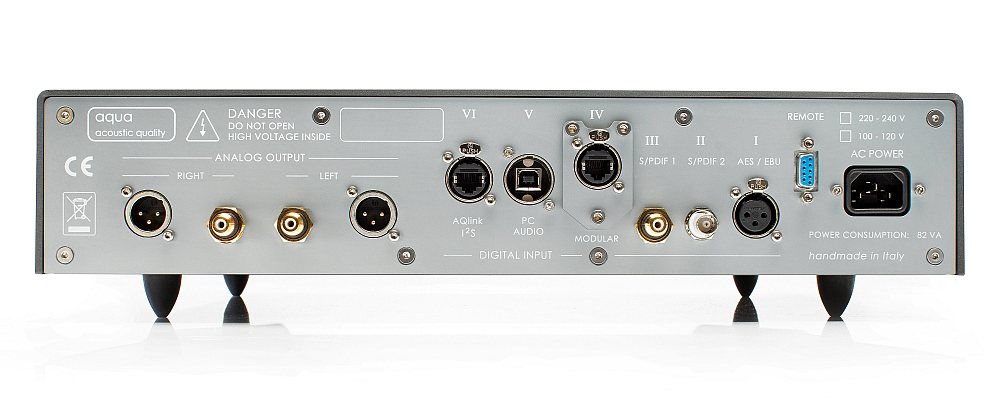
Likewise, the analogue and digital sections have separate low noise C-Core power supplies executed by extensive use of discrete BJT, Mosfet, J-Fet and ultra-fast diodes. Indeed, all parts in the Formula xHD are selected for “ultra-low RF noise” and the signal path itself is direct-coupled and completely capacitor free. With the exception of “six superior electrolytic capacitors, the caps used are Tantalum, solid polymer OS-CON and double metalized MKPs”.
The Formula xHD offers the choice of two analogue output stages, one single-ended and one transformer-coupled balanced which again use discrete BJT and J-Fets metal film “ultra-precision” resistors. I asked Anelli why he went with transformer-coupling rather than a fully active balanced output stage. He says, an “audio transformer creates a perfect virtual ground and it can be better galvanically isolated from the preamplifier”. In such a purist device, there is no volume control or headphone amplifier contemplated and, unlike the Aqua La Scala, there are no valves in the output stage so as to minimise noise and distortion.
A word of warning here: Given the high-density parts count, the unit takes many hundreds of hours to burn-in and settle down. It sounds warm and engaging when new but also a bit cloudy and slightly soft. Expect some occasional frequency anomalies particularly in bass response as it matures. After 500 hours or so, the rain clouds do lift and the xHD really opens up for transparency and resolution to become of the highest order.
Elevation
The Formula xHD, like other Aqua models and most R2R DACs, is non-oversampling (NOS) and eschews digital filtering or other sonic compensation in the digital domain. Aqua asserts that despite superior numbers on the test bench, upsampling/oversampling DACs are “rarely able to produce the same emotional and realistic results”. Anelli states further:
Due to the fact that the Formula xHD does not use oversampling filters, there is no need of an on-board high frequency clock generator. Some oversampling machines use PLL systems, in other cases there are sampling rate conversion systems. In lab measurement, these solutions can provide very low jitter values. But our philosophy here is also “listening first”.
The specific design goals for the xHD were to improve every aspect of the original Formula, both hardware and firmware. In particular, the xHD update involves a major refinement of the firmware code for the main FPGA of the R2R ladder converter, no doubt to accommodate full DSD compatibility via DSD over PCM conversion (‘DoP’). The xHD update also features a new hybrid dual core XMOS xCore 200 USB port with proprietary FPGA circuitry that enables fully floating (isolated) USB decoding of sample rates in “Bit Perfect” up to 24-bit/768kHz PCM and up to DSD256 (QUAD DSD via DoP). It continues to support FLAC and WAVE files and the like. But in relation to DSD, Anelli was adamant that DoP conversion is still the way to go for better sound:
As you know, it is possible to transform the DSD stream to an analogue signal in two ways: one is to apply a low-pass filter to the output and the other is to transform the DSD to PCM. The filtering can be done using an analogue filter, or you can use a semi-digital filter. With the analogue filter it is difficult to reach a good S/N (at least with a simple passive filter). The semi-digital filter is a FIR filter: it is possible to have good results, but it’s not an analogue filter. We experimented with the two filtering systems but to reach the best results in terms of noise and dynamics, our choice has been the PCM conversion. It is not the simple and easy way, but in our opinion is the best approach for DSD processing. In other words, we think the best musical performance can be obtained using (also for DSD) our high performance R2R ladder converter and to reserve for DSD a separate channel and filtering inside the DAC circuitry.
Other connectivity includes RCA coax and BNC coax S/PDIF along with an AES/EBU input (all to a maximum of PCM 24-bit/192 kHz or DSD64, via DoP). Prima donna red book luddites like me who own the superbly constructed Aqua La Diva CD transport (and a mountain range of polycarbonate) can also take advantage of a killer-sounding dedicated I2S serial bus dubbed the AQlink PRO, a jitter-free RJ45 digital interface that can also handle up to 24-bit/768kHz PCM and up to DSD256 (via DoP). According to Anelli, “with the appropriate circuits (digital buffers, transmitters, etc.) it becomes an uncompromising digital connection”. It certainly sounded that way to me and, as I have already stated, I have never heard lowly Redbook CD sound this good before. The highly capable La Diva top loader really warrants a review of its own.
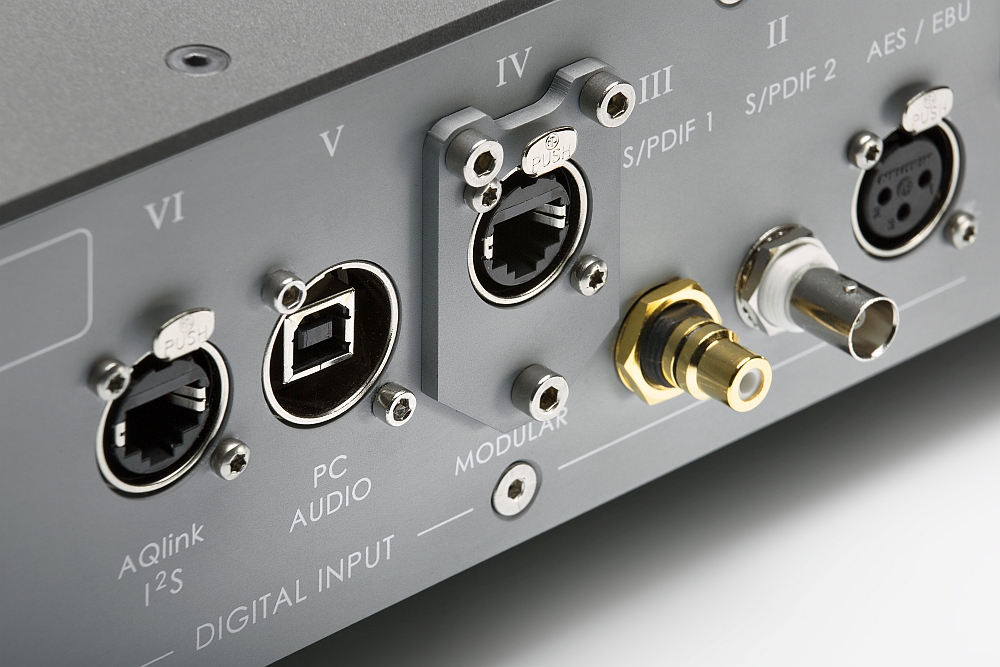
The last digital input is left open and indexes another key design feature of the Formula xHD. Modularity. Aqua products are not designed to be tomorrow’s landfill. They are open to future improvements in what is inarguably the fastest moving sector in audio. Each circuit and function in the Formula xHD is implemented on a separate board including each of the four resistor banks of the converter and so, like Leo Fender’s guitars, are replaceable and upgradeable in the field. Should you need more bits, as it were, or an Ethernet connection, please, that is not of the I2S variety alone…
One change you’re unlikely to see ever in Aqua’s products is the adoption of MQA. Anelli has obviously been asked this question often because he sent me a pre-prepared Aqua manifesto on the subject. In summary, over extended listening tests, Aqua’s evaluations of MQA were “not positive, especially with regard to the timbre and naturalness of the sound”. Because it’s not a lossless codec, “details in the recording are lost in the MQA encoding”. Even though Aqua could, no doubt, develop an FPGA to implement MQA decoding, its “fundamental approach compromises Aqua’s philosophy: the search for natural, dynamic sound with the least amount of artefacts”. Given Aqua’s investment in its proprietary converters and concomitant aversion to digital filters, Anelli says…
Adopting MQA, in which the original sound samples are compressed and submitted to heavy DSP operations, would mean compromising this approach which we are convinced is the right one… Even more serious is the fact that the type of digital filtering “imposed” in MQA results in similar, if not identical, performance on all “MQA” devices. This implies a “standardization” of products and their sound characteristics. Aqua instead prefers the freedom to continue to carry out what we have always done – developing the best, most engaging sound beyond passing trends.
Hear, hear ! says Ryohei Kusunoki who in the Japanese MJ Audio Technology magazine railed against the detrimental effects of digital filtering and oversampling for their perceived “diffusion of sound coherence” in the late digital dinosaur ‘90s. Now I’m not saying this is the only way to skin the digital rabbit and certainly no DAC whatever the implementation necessarily plays to type. To me this is a good thing, “I feel like more than just a number” in the “Computer Age”. But to continue…
The Formula xHD is manufactured entirely in Italy and weighs in at a solid 9 kg. The external casing comprises a solid aluminium faceplate of satin silver or black with a grey “suede” Nextel powder coated anti-resonant cabinet. A horizontal row of mechanical switches on the front for power, mute, phase invert and input selection (Roman numerals – you’ll get used to it) is reminiscent of ARC or CAT preamps of yore. Operation is confirmed by a number of green-lit LEDs as is the indication of sample rate. The xHD is self-effacing minimalist chic although its clean lines are just curvy and stylish enough to betray its Milanese origins. I found the xHD integrates nicely into whatever the supporting system, however its demure appearance won’t likely do much for those who crave gilded peacockery in the outward presentation of audio components.
The DAC’s functions are mirrored on a sleek and equally substantial IR remote control. The inclusion of the phase reversal button on the remote is, to my mind, a crucial touch (along with a repeat button). As Anelli told me, and I wholeheartedly agree:
It is known that the correct phase is important for the best music reproduction. A phase inversion is possible, amongst other things, during the recording process (cases are known in which the phase of the audio signal is different in subsequent remastering of the same musical material). The main effect detected by the listener is generally a narrowing of the sound scene, a blur or loss of solidity.
Speaking of blur and solidity, the xHD’s stock footers are of a soft, spongy, compliant type which cause the unit to literally do the shimmy shake on touch. The xHD is a ‘fast’ and lithe DAC but sometimes I feel these footers can ever so slightly smear or round off the leading edge of transients and deprive the bass of a smidgeon of drive. The unit proved to respond predictably to various after-market couplers.
Ultimately, I achieved the best balance in my system (without affecting the innate character of the DAC) using Les Davis Audio 3D2 Viscoelastic Discs between the stock footers and an original Shun Mook maple and ebony platform. Props also to Sablon Audio for its superb RJ45 Ethernet cable which I purchased to upgrade the I2S connection between the La Diva and the xHD. A short run of this cable resulted in a further lowering of the noise floor, broadened frequency extremes and an appreciable enhancement of the uncanny purity, ease, and lucidity that are already the raison d’etre of the Aqua Formula xHD.
See No Evil
Music sounds completely uncontrived through the Formula xHD converter. I’ve listened to literally hundreds of recordings through the xHD, from Bach to Berry to Blixa Bargeld, from Son House to Fun House, and the thing continues to enthral even when the recording quality is nothing special. It plays everything with a natural, unforced, unimpeded ease. This is perhaps its defining quality. Despite a warmish overall tonal balance, differentiation is superb and no two recordings sound the same. Especially interminable remasters of the same recording. It sounds so clean (as light) and unaffected, yet music through the xHD “burns with the fire of life” (Iggy).
What Kusunoki described as a “natural stress-free sound” is a hallmark of an R2R DAC. But few DACs of this or any architecture have the breathtaking transparency, openness and resolving power of the xHD after its aeonic burn-in period. Few have its ineluctable focus, analysis, and intensity of insight. Few have its precision, coherence and organisation. It has a natural way with timing, mood, and timbre that are second to none.
It is linear across a very wide bandwidth, it has extraordinary separation and can elucidate the minutest micro-dynamic inflection. It is noise-free and character-free, so present and revealing that, like a trouser leg on The Rutles, it leaves nothing to the imagination. But never once is the soul of the music stripped bare. In fact, the xHD does entirely the opposite. You’ll hear things you never dreamed of. Be taken to places, deep inside, few other components, digital or otherwise, seem capable.
Take Miles Davis In a Silent Way, for instance. This piece of music (and when streamed, the two sides of the original LP really cohere as a piece) is as deeply evocative as anything you’ll find in the Davis oeuvre. Neither rock nor jazz, the music unfolds as much by insinuation and by rhythmic suggestion as it does by traditional harmonic and melodic development. Through the xHD, the performance is stunning. The focus and precision, the sheer level of insight afforded, is absolutely scintillating. Resolution of timbre, particularly, is simply a revelation.
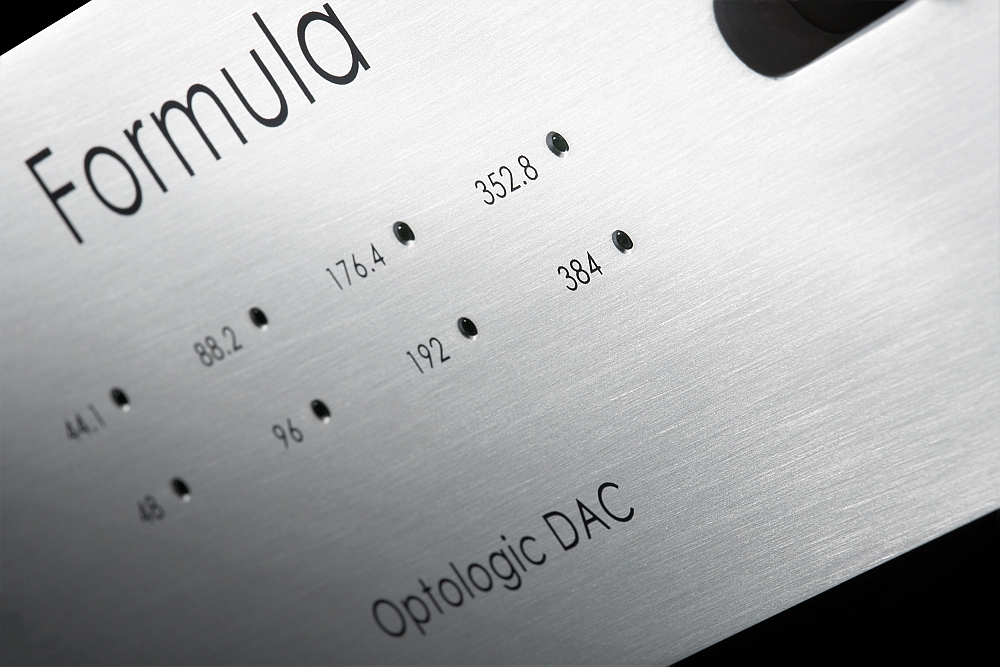
Tonal and textural contrast, so crucial to this music, is rendered with exquisite refinement and discrimination. I’ve never quite appreciated before how much chordal information and textural sophistication is actually contained in John McLaughlin’s humble Fender Duo Sonic II. Turn your attention to any of the performers and you get another fresh insight buzz. It happens with every recording played through the xHD, but it happens with such “Shhh/Peaceful” transparency and ease, you’ll never notice it’s in the chain.
Witness Davis acolyte’s Keith Jarrett’s classic The Koln Concert. On regular CD, through the xHD’s transformer-coupled balanced outputs, the piano sounds rich, full and tonally complex. It is noticeably free-flowing and organic. It has wonderful balance but also jaw- dropping dynamic scale, drama and propulsion. The treble is open, rather extended and airy with just a hint of alluring sparkle. It is completely devoid of grain. The midrange too is open and expansive: detailed, lively and very dynamic but is again so tonally pure and unconstrained.
As a result, the xHD casts a wide and particularly deep natural perspective both in terms of the finest gradations of soundstage layering as well as depth of image. Image stability is also spectacular: exceptionally precise and holographic but with outlines as heard in life. There is a real sense of the delineation of specific space and air around the performer and an equally remarkable sense of the unique atmosphere of the specific acoustic space.
The xHD may not be the last word in tonal colour and there are certainly more euphonic sounding DACs to be had elsewhere. The xHD works instead by reproducing touch and feel with the deftest of hands this side of pure analogue. There is nothing clinical, etched or hyper-real about the xHD. Nor does it over-smooth or over-sharpen the sound like so much modern Hi-Fi. If it’s been said before, I apologise, but Aqua by name and Aqua by nature – the xHD has a downright liquidity I have never experienced in digital to date.
Rather than beam the sound at the listener directionally, in the typical digital way, so the music sounds static and fractured, the xHD works by immersion and inner pressurisation. It’s intoxicating. I have no idea what Lydia Lunch was talking about when, in live performance recently, she blurted out in a ranting stream of consciousness that “Architecture is music frozen in space”. But I remember standing there thinking that she was definitely not talking about the Formula xHD.
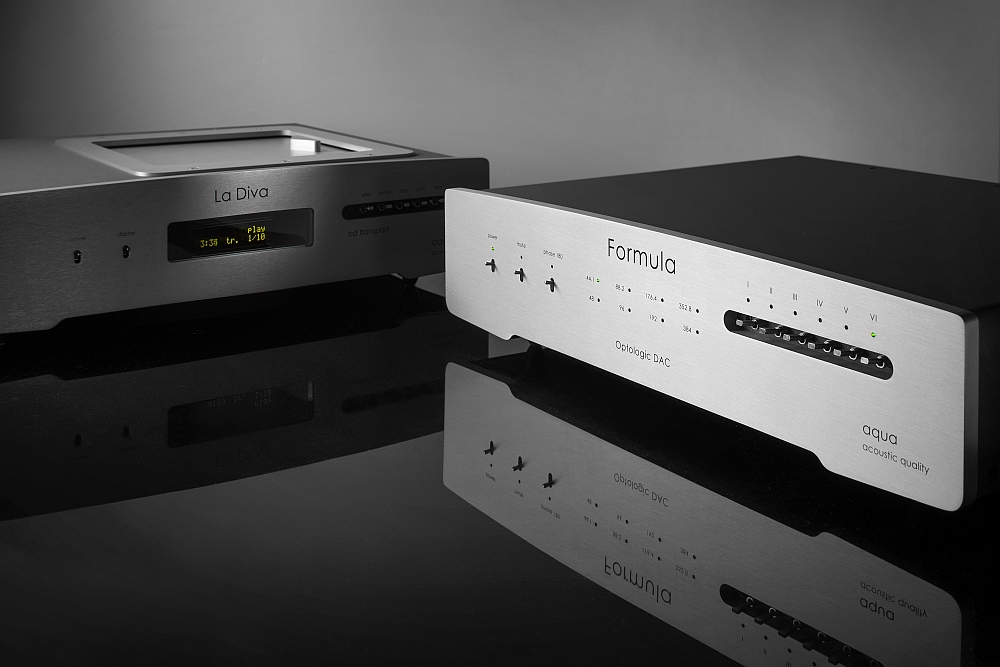
Last but not least – wanna’ hear the redemptive power of rock n’ roll? Check out Lou Reed’s Live in Italy, 1983 recording remastered again for the umpteenth time and one of my all-time favourite Reed releases, principally because it features the incredible guitar playing of ex-Velvets chronicler, ex-Voidoid and ex-tax lawyer, Robert Quine. Quine was a cantankerous cross between Chuck Berry, Albert Ayler and the electric Miles. Here, his spiked-up guitar interplay with Reed demonstrates just how well the xHD is able to separate complex strands in an often torrid mix and just how well the notes and beats arrive on time.
Despite a slightly laid back balance, the xHD has lightening quick reflexes and agility. Transient response and attack (as well as bleeding edge decay) are again extremely lifelike and natural sounding. The fluid, sinewy bass playing of Fernando Saunders also demonstrates that the xHD has excellent bass: tight, deep, solid, tactile, with superb inner detail and pitch definition. It may not be the hardest hitting low bass but it has the best timing, the most natural and human timing I’ve ever heard in a digital product and I wouldn’t trade that for all the silicon in the world. “White Light/White Heat”, indeed, it "tickles me down to my toes".
Conclusion: Satisfaction
I’ve used the Aqua Acoustic Quality Formula xHD, both as a USB DAC and in tandem with the stunning Aqua La Diva transport, basically since the inception of SoundStage! Australia in July 2017. As such, I’ve heard it over the long haul with a wide variety of equipment and it never ceases to amaze – or to inspire the supporting cast. Its inherent neutrality, its refined and revealing nature makes the job easy – and very, very enjoyable. Staging and imaging are pinpoint (and natural), resolution is pinpoint, timing is to die for. Focus, insight and analysis are simply mesmerising. Even now, I have to turn the damn thing off to finish this review.
But if I had to sum it up, the xHD is serene. It has that uncanny sense of purity and natural ease, a stress-free listenability that simply gets me closer to the music, and this not merely for a digital component. The xHD is capable of resolving the finest dynamic gradations, the slightest nuance of a musician’s unique touch, pressure and feel in the most human and, therefore, analogue of ways. Musicians call it their tone. The Aqua gets this masterfully right. To paraphrase Tom Verlaine, the xHD is able to express the lost word in music, all kinds of music, that other components either can’t, don’t or won’t enunciate. Whether this is because of its proprietary DAC architecture, its vanishingly low noise floor and/or its elimination of some hitherto unknown distortion artefact, the xHD is must audition for those seeking the most powerful emotional as well as analytical investment in their music.
Let’s face it, the digital-to-analogue converter is not only the fastest moving sector in high end audio but also the one of the most hotly contested in the “Who’s Next” stakes. It's also, it seems, the most polarising. Provided you dig the sound, and I do, the xHD’s modularity future-proofs the deal. Yes, I would like to see an Ethernet port added. I would like a bit more colour (but not euphonic colouration) and a bit more punch and drive in the lowest registers. But not if that means changing everything the xHD already does so well. A further optimisation of the XMOS code/firmware is envisaged in 2019 with native DSD up to 512 and the device is soon to be Roon Ready.
For me, for the time being, and especially when you factor in the xHD’s value for often bleeding edge performance, I’d call it a “bargain and the best I ever had”.
…Peter Katsoolis
soundstageaustralia.com
Associated Equipment
- Speakers - Wilson Audio Sasha 2 and Sabrina; Shun Mook Bella Voce; M8 Audio Sweet Maxwell
- Amplifier - VTL MB 185 Signature Series iii; Wavelength Audio Napoleon 300B; SPEC Corp. RSA - M3EX; Pass Labs XA 25 and First Watt F7; BAT –VK655SE (for review)
- Preamplifier - Thrax Audio Dionysos; VTL 6.5 Signature Series ii; Pass Labs XP - 22
- Source - Aqua Acoustic Quality La Diva transport; Metrum Acoustics Hex DAC; Auralic Aries Streamer; Nagra HD DAC
- Cables - Shun Mook RCA; Acoustic Revive XLR-1.OPA II; Sablon Audio RJ45 CAT; Skogrand Wagner AC and Luna Orange PC; Vermouth Audio Black Pearl loom; Luna Cables Rouge loom
- Equipment Support - Shun Mook; Mana Acoustics
- Accessories - Les Davis Audio 3D2 Viscoelastic discs and mat; Shun Mook Mpingo and maple and ebony boards; Nordost QRT products and Sort Kones BC; Acoustic Revive RIQ- 5010 and 5010W resonators; SPEC Corp. RSP-AZ1 Real Sound Processor; Ikea Aptilig butcher’s blocks
Aqua Acoustic Quality Formula xHD DAC
Price: AU$23,795
Warranty: Five Years
Australian Distributor: Magenta Audio
+61 8 8390 1673
www.magentaaudio.com.au
AQ TECHNOLOGIES S.r.l.
Via Luciano Manara, 17 - 20122 Milano
Italy
+ 39 338 230 0347
www.aquahifi.com

